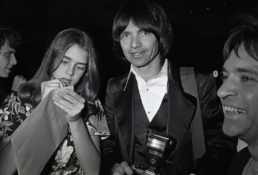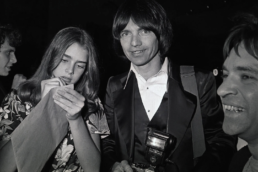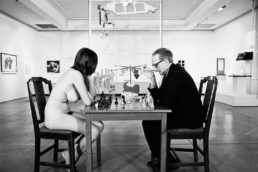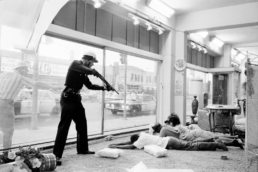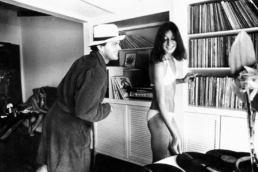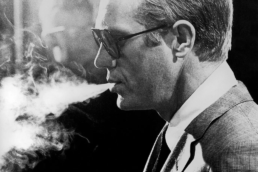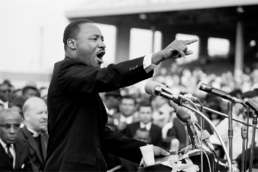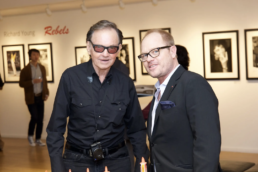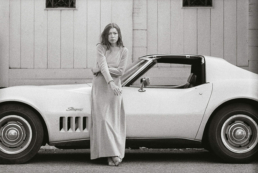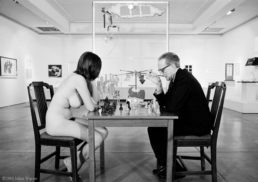Julian Wasser
Julian Wasser, the ‘Photographer Laureate’ of L.A., Dies at 89
Julian Wasser
In the 1960s and ’70s, he created indelible images of the city’s combustible mix of art, rock ’n’ roll, new Hollywood and social ferment.
By Penelope Green | Feb. 14, 2023
Julian Wasser, the artful and rakish photojournalist who chronicled the celebrity culture of Los Angeles that began percolating in the 1960s — a heady, sexy and often combustible brew of new Hollywood, art and rock ’n’ roll — as well as the city’s darker moments, creating some of the most indelible images of that era, died on Feb. 8 in Los Angeles. He was 89.
His daughter, Alexi Celine Wasser, said his death, in a hospice facility, followed a couple of strokes he suffered in September.
When the Rev. Dr. Martin Luther King Jr. spoke at a civil rights rally in Los Angeles in 1963, Mr. Wasser was there. When the Watts neighborhood erupted in riots in 1965 after a Black man there was brutalized by the police, Mr. Wasser captured the agony of a city at war with itself.
And when Robert F. Kennedy addressed his supporters at the Ambassador Hotel in Los Angeles in 1968, after winning presidential primaries in California and South Dakota, Mr. Wasser photographed the joyful young senator, just moments before his assassination.
Yet Mr. Wasser was perhaps better known for chronicling L.A.’s counterculture and its outsize bohemian characters: He shot a bikini-clad Anjelica Huston and Jack Nicholson horsing around in a living room; Steve McQueen on a movie set, exhaling a plume of smoke and exuding a glacial cool; and countless scenes from the Whiskey a Go Go, the hot nightclub on Sunset Boulevard.
Mr. Wasser was also the perpetrator of “that photo” of Eve Babitz, the late author and sensualist, then age 20, naked and playing chess with the artist Marcel Duchamp, a stunt hatched during the artist’s retrospective at the Pasadena Art Museum in 1963. The museum’s director, Walter Hopps, happened to be Ms. Babitz’s (married) boyfriend.
Stories, and memories, have varied over the years, but as Ms. Babitz told it, the photograph was an attempt to annoy Mr. Hopps, who took his wife instead of Ms. Babitz to the exhibition’s opening.
Mr. Wasser said that the composition was his idea. “I had always wanted to see Eve naked,” he said in an interview with The New York Times for her obituary in 2021, “and I knew it would blow Marcel’s mind.”
The black-and-white image became so famous it showed up in a poster for the Museum of Modern Art in New York. The art critic Calvin Tomkins, Duchamp’s biographer, called it “an erotic and very Californian footnote to Walter Hopps’s historic show.”
James Danziger, one of Mr. Wasser’s gallerists, said Mr. Wasser had “brought an artist’s eye” to his photojournalism.
“You could call it the auteur theory of photography,” Mr. Danziger said. “You let things happen, but if it made for a better picture, you weren’t afraid to direct the scene.”
And then there were the photographs of Joan Didion, commissioned by Time Inc. in 1968, shortly after her essay collection “Slouching Towards Bethlehem” appeared. There is Ms. Didion, steady eyed and brandishing a cigarette, in a variety of poses with her Corvette Stingray, potent images now etched into the collective consciousness.
The pictures appeared on Ms. Didion’s books, were recreated by the fashion company Celine in a homage to the author featuring the model Daria Werbowy, and were the subject of a 2015 show at Mr. Danziger’s gallery in Manhattan. They could even be spotted on tote bags, as Ms. Didion’s nephew Griffin Dunne did on the subway on his way to her memorial, sported by young women who were also en route to the service, Didion groupies with literary swag.
When Mr. Dunne interviewed Mr. Wasser for his 2017 documentary, “Joan Didion: The Center Will Not Hold,” Mr. Wasser recalled how he had shot only two rolls of film that day.
“He knew he got it right away,” Mr. Dunne said. What he did not anticipate, he added, was how people would react to the photos. “He never dreamed they would be on tote bags, as iconic as a Che Guevara T-shirt,” he said.
With his shaggy hair, leather jacket and holster of beepers and police scanners, an assortment of cameras and press badges slung around his neck, Mr. Wasser was quite a presence himself, said Craig Krull, a gallerist who represented him for the last 30 years. “He had an unflinching eye for the intensity of experience in L.A.,” Mr. Krull said, “whether it’s a club on Sunset Strip or the Manson murders or the Watts riots.”
Mark Rozzo, whose 2022 book, “Everybody Thought We Were Crazy: Dennis Hopper, Brooke Hayward and 1960s Los Angeles,” covers much of the territory that Mr. Wasser did and used one of his photos — of Ms. Hayward and Mr. Hopper looking especially mod and particularly glum — said that Mr. Wasser was “perhaps the closest thing that Los Angeles has had to a photographer laureate.”
At least for his rollicking moment. “This was the period of Didion writing in The Saturday Evening Post and Ed Ruscha’s street-inspired pop art and Brian Wilson’s teenage symphonies to God,” Mr. Rozzo said. “Julian was right in the center of it all, and he made sure he was at the center.”
Julian Wolf Wasser was born on April 26, 1933, in Bryn Mawr, Pa., the only child of Leo and Frances (Rothman) Wasser. His father was a lawyer, his mother a schoolteacher. He grew up in the Bronx and Washington, D.C.
A teenage news junkie, Julian cut school and sneaked out of his room at night in imitation of his hero, Arthur Fellig, the photographer better known as Weegee, to chase down crime scenes with a police scanner and submit the photographs to newspapers, which inevitably published them.
“Every night I would climb out my bedroom window and steal my father’s car when I was 12 and take pictures, and they’d be on the front page of The Washington Post,” Mr. Wasser told a television reporter in 2019. “My father would say, ‘Look, there’s another Julian Wasser in Washington.’ I said, ‘Yeah, Dad.’”
He worked as a copy boy for The Associated Press in Washington and, by his account, was able to meet Weegee and accompany him to crime scenes when the photographer visited Washington.
His daughter said that as a child she was often deputized as her father’s assistant. She monitored his ever-crackling police scanner: “Daddy, the night stalker is being arrested!” (She was 4 years old at the time.)
When Will Smith married Sheree Zampino, his first wife, the Wassers crashed the wedding. Alexi Wasser, then 11, was armed with a disposable camera, which she was savvy enough to stash under her shirt when security arrived to remove the unauthorized photo team. She recalled her father saying with a straight face, “I’ve never seen that kid before.”
“It was all very absurd and ridiculous,” she said. “Later Julian told me my photographs ran in whatever tabloid he was shooting for, but he stole my credit line. Our relationship had a very Ryan and Tatum O’Neal ‘Paper Moon’-esque quality.”
In addition to his daughter, Mr. Wasser is survived by a son, James.
In 2014, Mr. Wasser published a photographic memoir, “The Way We Were,” more than 170 pages of his greatest hits, and then some.
“The effect of so many otherworldly behind-the-scenes pictures plays out like a kind of movie in itself,” Rebecca Bengal wrote in the New York Times magazine T. “As Wasser captures them, in grainy close-ups and candids, the ’60s, ’70s and ’80s marked a time of unusual access: carefree, hair-let-down moments and stars mingling with real people.”
“It wasn’t like it is now,” Mr. Wasser told The Guardian in 2014. “There were no paparazzi, no VIP sections, no security. It was a really innocent time. You’d just walk up and there they were. They’d stop and smile and pose.
“Now it’s a business,” he continued. “If you want exclusive access to a celebrity, you have to pay big money. You weren’t considered some sort of psychotic menace who’s going to rob or kill them either. Now they’ll call their security person and you’ll get beat up.”
A correction was made on Feb. 15, 2023: An earlier version of a picture caption with this obituary misstated when the photo of Jack Nicholson and Anjelica Huston was taken. It was 1974, not 1971.
Joan Didion Remembers the Day Julian Wasser Took Her Portrait
Julian Wasser
Vogue spoke with Joan Didion and Julian Wasser about his portraits of her, now in Wasser’s new monograph, The Way We Were.
BY ABBY AGUIRRE
Shortly after Slouching Towards Bethlehem was published, in 1968, Timemagazine commissioned portraits of Joan Didion by the photographer Julian Wasser. You know the series: a young Didion in a long-sleeved dress and sandals, standing in front of her Corvette Stingray, a cigarette dangling from her right hand. Two of these portraits appear in Wasser’s new monograph, The Way We Were, published recently by Damiani, alongside many of his other seminal photographs: Steve McQueen exhaling a cloud of cigarette smoke; Robert F. Kennedy five minutes before he was shot; Roman Polanski kneeling near the entrance of the house on Cielo Drive, the word PIG,scrawled in blood by the Manson family, faded but still visible on the door.
Of all the pictures he took during those years, Wasser says, speaking by phone from Los Angeles, the ones of Didion were “a big event in my life.” “I’d read her fiction,” he says. “It was very L.A. She didn’t miss a thing. She was such a heavyweight person.” Wasser shot Didion on the Strip and at her rented house on Franklin Avenue in Hollywood, where she lived with her husband, the writer John Gregory Dunne, and their daughter, Quintana Roo. “It was a very nice, cozy house,” Wasser remembers. “And she was a very easy person to talk to. It was like a dream. Quite nice and relaxed. No Hollywood phoniness.” Vogue asked Didion, too, for her memories of the shoot.
These portraits were commissioned by Time in 1968, just after Slouching Towards Bethlehem was published to great acclaim. What do you remember about this moment in your life?
I think someone said that the picture had been taken under circumstances that it hadn’t. What do I remember? I can’t say what I remember. I had a baby. I was living in a rented house in Hollywood. It was kind of a wonderful period of my life actually. Not because I was in a rented house in Hollywood. But just in general.
As a writer and reporter, was it strange for you to be the subject of a story? To be appearing in Time?
I don’t think it was the first time I’d been written about. The whole thing was strange. Yes, it was strange to be written about. But that probably wasn’t the first time. I loved having pictures of me with the baby. The one where she has sort of—the one that shows her hair pulled up tight? I love that picture. I love that picture. That was also at Franklin Avenue. Most of what Julian Wasser took was at Franklin Avenue.
Was this the first time you met Julian Wasser? Were you familiar with his work?
I was very familiar with his work because I was writing for magazines then and he was at the Time bureau. Any time anyone was shooting in L.A. for Time and Life, they were shooting with Julian. He was just somebody I knew very well.
What details do you remember about that day? Does anything in particular stand out to you now?
I can’t remember anything specific that stands out about the day. I don’t know how we decided to include the Corvette. It must have been some whim of Julian’s.

He said it was not his whim. He said, “You don’t tell a woman like that what to do.”
[Laughs] Oh, really?
Had you thought about what you were going to wear, or were the long dress and sandals just what you happened to have on?
I remember the long dress. I remember being out on the Strip in a long dress. Why, I can’t imagine.
Do you remember buying the Stingray?
I very definitely remember buying the Stingray because it was a crazy thing to do. I bought it in Hollywood.
What color was the Stingray?
The Stingray was Daytona yellow. Which was a yellow so bright, you could never mistake it for anything other than Daytona yellow.
Did you like these photographs of you?
The picture with the baby—I would say that was my favorite picture ever. Julian took beautiful pictures. Anybody who had their picture taken by Julian felt blessed.
How did you feel about the article?
I don’t remember the article. I remember the pictures.
Legendary photojournalist Julian Wasser reflects on career, discusses Chicago exhibit
Julian Wasser
CHICAGO (WLS) — Julian Wasser has witnessed Hollywood through a camera lens for well over half a century, capturing images of stars from Jack Nicholson to The Beatles, and he even got one of the very last pictures of Robert Kennedy before his assassination.
The view can be seen in a special exhibit, “Julian Wasser: The Way We Were,” a photographic time capsule of the 1960’s and 1970’s.
ABC7 Chicago’s Janet Davies talked to him about his new exhibit that opened Friday in River North.
Wasser began shooting spot news in the nation’s capital at a tender age.
Julian Wasser: “Every night I would climb out my bedroom window and steal my father’s car when I was 12 and take pictures, and they’d be on the front page of the Washington Post. My father would say ‘look, there’s another Julian Wasser in Washington.’ I said ‘yeah dad.'”
Later Wasser’s camera took him to New York then Los Angeles, shooting stars for publications like Time Magazine, Vanity Fair and Life Magazine.
Wasser: “Most photographers would get a star, line them up against a wall and stand there and don’t say anything. They would wait for the star to do something, I can’t stand that. They want direction. I gave lots of directions. They liked that and worked well with that. That’s why pictures look the way they do.”
Wasser’s career has spanned over six decades, and each of his iconic photographs has a story.
Wasser: “The Beatles, which was taken in London in Soho. Jayne Mansfield was at the Whiskey, I was shooting for Life Magazine. David Bowie, I was working for him, shooting at the Hollywood Bowl at one of his concerts.”
Janet Davies: “How about that Hugh Hefner photo on roller skates?”
Wasser: “He had incredible luck with women, didn’t he? He was actually a very, very nice guy, very sweet guy, he treated those girls like queens.
Davies: “What about the Marilyn one?”
Wasser: “I wanted to look at her, so I sat at her feet like a lap dog and took the pictures; she didn’t even know I was there, she’s a star!”
Wasser’s iconic photos are on display at the Hilton-Asmus Contemporary Gallery through September 30th.
“Julian Wasser: The Way We Were” runs through September 30th at the Hilton-Asmus Contemporary Gallery.
Wasser will be at the exhibit Friday from 6:45 p.m.- 9 p.m.
Hilton-Asmus Contemporary
716 N. Wells St., #3739, Chicago, IL 60654
www.hiltoncontemporary.com

